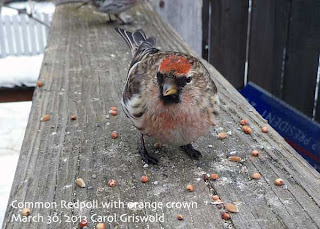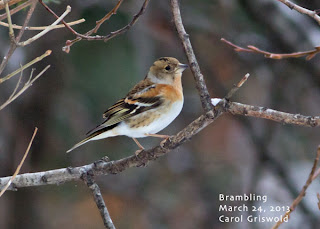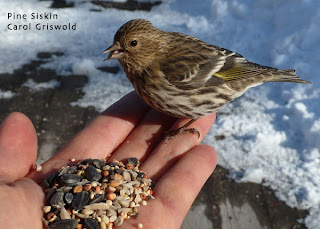Seward,
Alaska Sporadic Bird Report
Sunrise
7:45 am, sunset 8:23 pm, length of day 12 hours, 37 minutes. It's light until
almost 9 pm! Tomorrow will be 5 minutes and 30 seconds longer.
Weather:
Yin and Yang. After a week of almost brutally intense sunlight magnified by a
surprise dump of 13" of snow, temps in the teens, and a howling wind
creating ground blizzards, it's now calm, 30º, overcast and snowing gently.
Ahhh… for now. More snow, snow showers, and rain in the forecast with
increasing winds. Spring wears Winter's face. Solstice blew right by me on
March 20, it was so wintery!
The
thick snow blanket keeps the birds focused on the feeders. Many, many hundreds
of COMMON REDPOLLS, and PINE SISKINS fill the air, darken the snow, decorate
the trees, and cover the feeders. A single Siskin actually has a delightful
little conversational song, but all together it's a cacophony of trills and
zzzzips.
Add
the loud VARIED THRUSHES, rapid-fire announcements of the STELLER JAYS,
talkative MAGPIES, the zippy WHITE-CROWNED SPARROW, happy SONG SPARROW,
trilling JUNCOS, a pair of BALD EAGLES crying overhead, the croaking of RAVENS,
cawing of the occasional invading NW CROWS from the beach, and cooing of
unwelcome PIGEONS. Quite a symphony! It's a wonder to watch and listen.
A
NORTHERN GOSHAWK heard the racket. On Friday, it darted in and hauled off a
small bird. It is one of the few raptors here, and is probably eating rather
well. It's not the only predator, however. A feeder watcher in Forest Acres
reported that a Pine Siskin bumped softly into a window and landed on the deck.
Instantly a Steller's Jay swooped down, grabbed it, and hauled it off into a
tree where it presumably ate it. No wonder the little birds flee in panic when
they hear a Steller's Jay approaching!
Those
vibrant VARIED THRUSHES serve as my morning alarm clock, even over the recent
whistling wind. Eight hopped around the feeder with more clucking and singing
in the tree branches, and more at other yards and feeders. It's an unusual
number so early. A lovely female Varied Thrush cautiously entered the feeding
frenzy; her right eye was injured and closed. I hope she can make it with such
limited vision, poor bird.
Other
feeder birds this week included a LINCOLN'S SPARROW, WHITE-CROWNED SPARROW
(also singing), GOLDEN-CROWNED SPARROW, FOX SPARROW (with a droopy left wing,
but it can fly), SONG SPARROW, AMERICAN TREE SPARROW, DARK-EYED JUNCO, OREGON
JUNCO, a single GRAY-CROWNED ROSY-FINCH, two male DOWNY WOODPECKERS, and one
female.
Just
before dark, all the music suddenly ceases and the Redpolls vanish to their
secret roosts. Then the CHESTNUT-BACKED CHICKADEES and RED-BREASTED NUTHATCHES
dart in to grab a few seeds. The mobs of finches are too intimidating for these
shy residents. It's a wonder they can survive on so little.
Again
I enjoyed sitting for a bit near one of my feeders with seed in my outstretched
hand. Within a second, a PINE SISKIN hopped on and began feeding and vigorously
defended its new-found stash against all intruders. The bright yellow feathers
flashed when he opened his wings wide and lowered his head, chattering. Often
the defender tangled with another siskin and fell off, letting a bystander feed
for a millisecond. It was quite entertaining. The less aggressive Redpolls fed
on my knee or on the ground by my feet.
Driving
nowhere and walking just a few steps today, I glassed the surrounding Mt Ash
trees and found a bright BRAMBLING. Nearby sat another! And then a third one
blasted by and chased both away. THREE BRAMBLINGS in my yard! I was happy to
get photos of them, and believe one much more pale bird might be a female.
Maybe they will stay and nest!
Zorro,
the SIBERIAN ACCENTOR, has not been seen since Wednesday. I've been looking as
time permits without any luck since my last sighting on Monday. The Bird also
eluded two dedicated birders from Fairbanks and Delta Jct who drove through a
blizzard on Turnagin Arm on Friday and diligently watched the hotspots in a
snowstorm the rest of that day and on Saturday, aided on the second day by a
Homer birder. Steve and John deserve the Zorro award for their hard work!
Of
note:
Kenna
Sue and Susan reported a first-of-season HERMIT THRUSH and two Tree Sparrows on
Monday, March 18th.
The
Burke family birded on a lovely day on Thursday, March 21, just as the wind
died down and before the clouds rolled in. The highlights of their amazing list
included 2 ANCIENT MURRELETS in front of town by the Community Playground, a
GOLDEN EAGLE in the mountains on the east side of the bay, a single
GREEN-WINGED TEAL female in Spring Creek, two FOS AMERICAN WIGEON, 35 ROCK
SANDPIPERS, and two SHORT-EARED OWLS at the tidelands, 2 BRAMBLINGS, and 20
RUSTY BLACKBIRDS at the horse corral.
Many
fine birders have visited Seward this winter. If you are willing to share your
Seward sightings with me, please drop me an E at c_griz at yahoo.com. I really
appreciate your reports.
Happy
Birding!
Carol
Griswold

















This Brambling looks like a female to me:
And this bright Brambling is a male.


Thanks to Martin Renner for
this information:
"Bramblings are best sexed by the color of the crown
(according to Svensson). So yes, you got a male and a female there. The male on
your blog is already molting into alternate plumage. To get a fully black head
it mainly needs to wear off some of the white fringes on the black facial
feathers. Great shots!"
And thanks to Aaron Bowman for this further information:
"It does look like the male
Bramblings are starting to molt into their spring plumage, with maybe some more
dark on their face, around the eye and bill and perhaps brighter wing markings.
Eventually the male's bill will also turn black and the whole head and back
will be black. If I remember right from Japan it will be around late April
before they are in full breading plumage.
A good way to be pretty
sure of the female in all plumages is their gray nape between their back and
their head, framed by the two dark lines falling down their crest. The shots
you took look correctly labeled to me."






















































